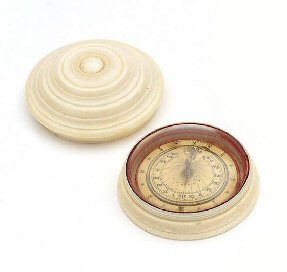THE PORTERS AND THEIR CLOCKS
A brief family history by John Porter.
On the 19th October 1682, Matthew Porter signed his apprenticeship papers and was bound
apprentice to master clockmaker Thomas Taylor of The Strand, London.
Thomas Taylor, Freeman of the Clockmakers Company, was a leading clockmaker of that time,
being listed as Assistant Warden of the Clockmakers Company when it was granted Letters
Patent and the right to bear arms in 1671 and was to become Master of the Clockmakers Company in 1710.
He had learned his craft from Richard Masterson
who made clocks in London between 1610 and 1633 and was a founder subscriber in 1630
of the Worshipful Company of Clockmakers, becoming its Master in 1668.
Matthew Porter is believed to be the great-grandson of Endymion Porter (1587-1649),
a prominent member of the court of King Charles I, patron of the arts and whose painting
by William Dobson hangs in the Tate Gallery.
Unfortunately no clocks made by Matthew
who was made a Freeman of the Clockmakers Company in 1692 are known to have survived.
Matthew's son Francis was apprenticed in 1717 to Charles Guy, and his sons Samuel and Mark
were apprenticed to their father.
Mark Porter, grandson of Matthew, moved out of London and set up his business in Wokingham
in Berkshire. The shop that he opened in the market square still stands and is now a chemist shop.
It was here that the earliest surviving Porter clock was made by Mark circa 1750.
Mark had eight children, four followed the family tradition and became clockmakers and
several 30 hour long case movements made by them have survived. One of the four children
was in fact a daughter, Ann, who became a master clockmaker and it is surprising to note
in this present age of so called women's liberation that female clockmakers were admitted
as apprentices by the Clockmakers Company as early as 1715, and some were even made Freeman
of the Company. Even earlier records show that a certain Robert Browne was apprenticed to
Katherine Ames in 1684.
A 30 hour movement made by John and Samuel has an 11 inch hand painted dial inscribed
"J & S Porter Workingham". It is interesting to see the four different spellings for the
same town, Oakingham, Woakingham, Workingham and Wokingham, a history of the name can be found HERE.
Samuel was also a member of the Institute of Instrument Makers, and in 1824 patented a floating sundial.
This is a very clever device as it works like a magnetic compass, the user therefore does not need to
know the position of North in order to tell the correct time. Some of these
of these sundials inscribed "Sam'l Porter Fecit." have survived, two of which are in the collection
of the National Maritime Museum
 |
 |
A more detailed Catalogue of clocks made by the descendents of Matthew Porter can be found HERE
Samuel's son Alfred William moved to a substantial house on the main London to Winchester
road in the small Hampshire village of Hartley Wintney and set up his business there in 1844.
It is fortunate that Alfred had the foresight to move to a large house, as he and his wife Sarah
had thirteen children! The house which has remained almost unchanged to the present day, still
houses the shop and workshops where Mark, the ninth generation of the clockmaking Porter family and his son Rex Porter
still carry on the business.
The family tree shows how the craft of clockmaking has
been handed down from father to son for nine generations since 1682 and A. W. Porter & Son must be
one of the longest surviving family businesses still serving its customers after over 300 years.
In 1994 A. W. Porter & Son celebrated the 150th year of its foundation by Alfred Porter in
Hartley Wintney and this was reported in the local press, Television and Radio.
 |
Rev. 1.0 jp 26.04.1998
Rev. 1.7 jp 28.01.2015